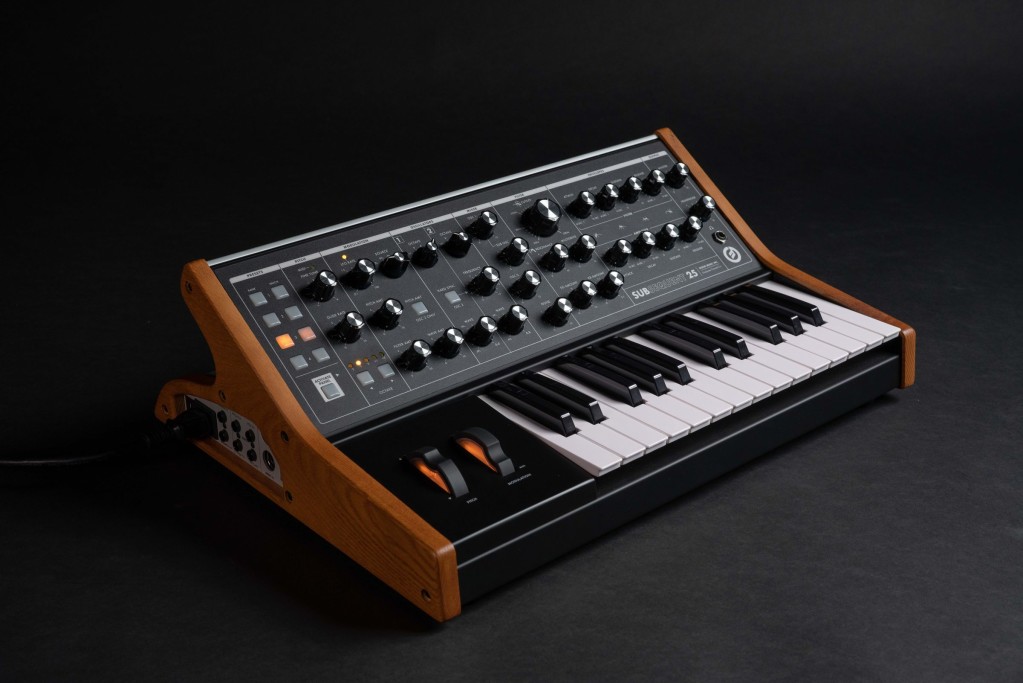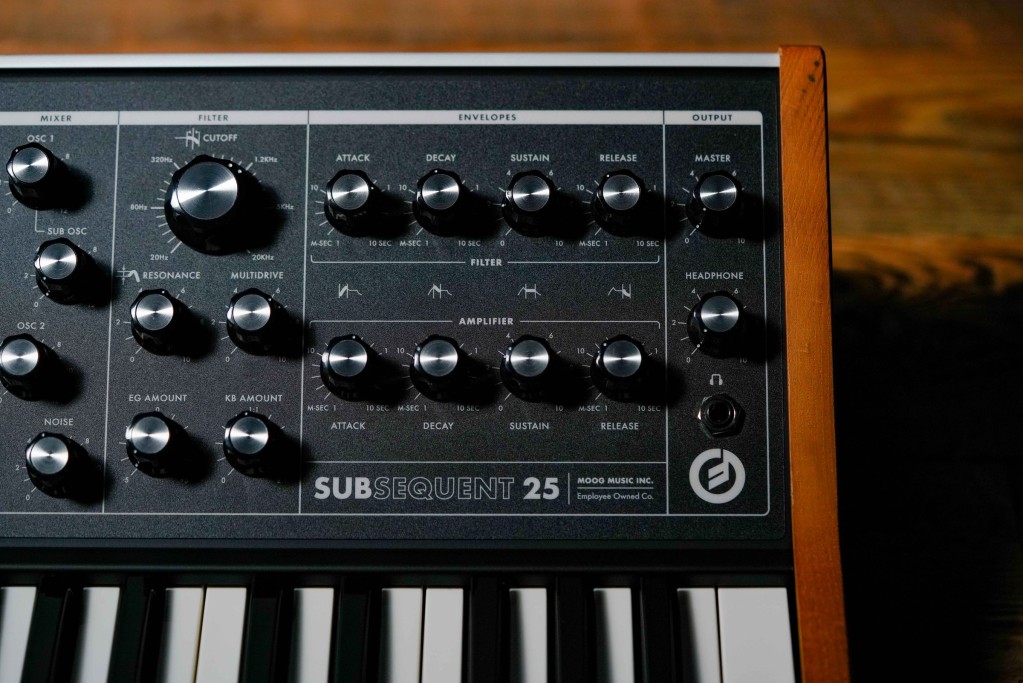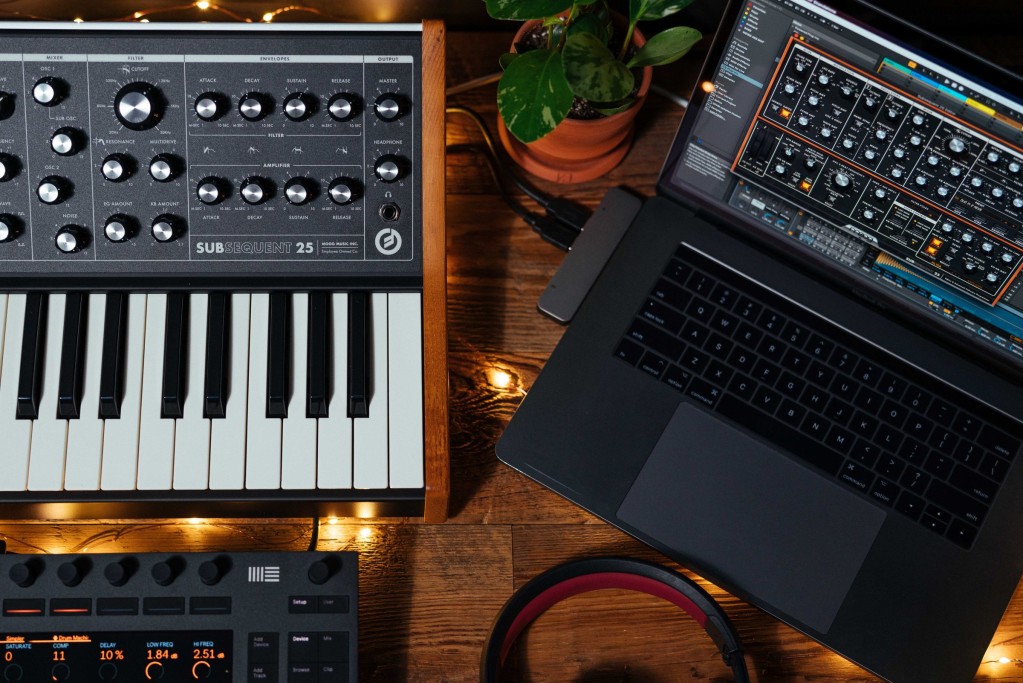For all Moog’s synths, it’s been a while since there was a sweet spot that said – oh, if I want a Moog, I should start here. The Subsequent 25 could be that instrument.

Okay, “subsequent” feels a little too much like an SAT word, compared to the endearing “Little Phatty” and “Sub Phatty.” But you could call this thing practically anything – it’s a cute little Moog, and about as Moog-y looking as anything since the 1970 Minimoog.
It’s just … adorable. I mean, someone should say that, because I fully expect this Moog will trigger some serious consumer instincts.
And appreciating that synths for a lot of musicians are about feelings and fantasy, Moog are repeating their collaboration with Flying Lotus to make an animated short film. (Scoff all you like – if you had a marketing budget, wouldn’t you want to spend it like this?) The inimitable Brainfeeder maestro FlyLo teams up with designer-musician Julian House. You might have heard House’s own music as The Focus Group and Ghost Box label, but you almost certainly know his album covers for the likes of Oasis and The Prodigy.
Anyway, this is all good fun. Here:
Okay, but you probably do want specs, too. In the year of polysynths, this isn’t that – it’s a massive bass synth that also happens to have a new Duo Mode to split osc 1 + osc 2.
So you have three oscillators – including one sub oscillator – and additionally a noise source
Four CV inputs, which is a decent-sized complement for a mid-range analog synth.
Multidrive, which combines two types of distortion to color the sound (and really makes all of this dirty and interesting).
It’s a Moog, so yes, there’s a Ladder Filter, but with 6, 12, 18, and 24 dB/octave slopes.
Audio input as well as (mono) output
USB and MIDI and full MIDI implementation – that’s actually a bigger deal than it seems, as there’s MIDI control of everything, including things like gate reset. Paired with the right sequencer, this could be a total beast.
Flexible LFO, with tri, square, saw, ramp, S&H shapes
It’s heavy – 16 lbs – over 7 kg. But you probably like that if you want a Moog.
Proper pitch and mod wheels
Now that the rational part of your brain is engaged, it’s also worth saying that you might want to save up for the powerful Subsequent 37, the Sub 25’s bigger sibling. It’s a significant price difference (though there is the used market). But in addition to more keys, the big draw of the Sub 37 is – more hands-on controls, more envelopes and modulation, and a built-in arp/step sequencer.
Sounds:
(Writing synth press releases is hard. Duophonic synths require you to sound like you’re an over-excited Leonin or Perotin attending NAMM – “opening new doors of musicality by playing two different notes at once.” Wait ’til the monks and sisters catch THIS bad boy!)

There’s also editor/librarian software included free, so the notion is you can extend the 16 x 16 (256) onboard patches with more stuff on the computer. And that’s what makes this somewhat unique: it is an analog synth, but it’s one that you might go deep into editing or sequencing. It’s obviously a performance-oriented, jam- and improv-focused keyboard axe, but it’s got enough CV that you could still devise some detailed patches with modular or semi-modular gear.


Moog have staked out this territory as the premium synth makers, and that’s what this looks like. It’s a pretty middle-of-the-road synth, but with tons of detail – and that Multidrive thing makes sure it isn’t too tame.
And for all the creativity of the Moog line lately, I fully expect the Subsequent 25 will get people past the hump of trying to decide what to buy. I’d say shame about the name, but I bet a lot of people just call it Moog.
US$895 list.
For more Moog film watching, check this behind-the-scenes with Uncut Gems composer Daniel Lopatin:
As an addendum, and part of why I think this appeals to the frontal lobes (even as the design triggers some irrational emotional appeal), here’s the amount of stuff you can control with MIDI – including high-resolution output. Even if you don’t use this via MIDI, it’s an interesting window into the architecture.
The flipside of this, though – you don’t have hands-on access to a lot of this without the editor. So if you want more controls, consider the 37. (This is the other downside of Moog having those spacious layouts and huge knobs, but hey.)
- Mono/Duo Mode
- Duo Osc 2 Priority
- Filter Velocity Sensitivity
- Volume Velocity Sensitivity
- Ext. Audio Level
- Osc 2 Beat Frequency
- VCO Gate Reset
- LFO Gate Reset
- Pitch Bend Up Amount
- Pitch Bend Down Amount
- Glide Legato
- Glide Type
- Filter Poles
- Wave Mod. Destination
- LFO KB Tracking
- LFO Range
- Filter EG Reset
- Amp EG Reset
- Legato
- Gate On/Ext.
- MIDI Ch. In
- MIDI Ch. Out
- Local Control
- 14-Bit MIDI Output
- MIDI Path In
- MIDI Path Out
- MIDI Merge DIN
- MIDI Merge USB
Specs:
- Sound Engine Type(s): Analog (2 x Oscillators, 1 x Sub Oscillator, 1 x Noise Generator)
- Number of Keys: 25
- Type of Keys: Semi-weighted, Velocity-Sensitive
- Other Controllers: Pitchbend, Mod Wheel
- Polyphony: Monophonic, 2-Note Paraphonic
- LFO: Triangle, Square, Sawtooth, Ramp, Sample & Hold
- Filter: Moog Ladder Filter with 6/12/18/24 dB per Octave Slopes
- Number of Presets: 16 (4 Banks of 4)
- Effects Types: Multidrive
- Audio Inputs: 1 x 1/4″ (ext in)
- Audio Outputs: 1 x 1/4″
- USB: 1 x Type B
- MIDI I/O: In/Out/USB
- Other I/O: Filter CV in, Pitch CV in, Volume CV in, KB Gate in
- Software: Plug-in and standalone editor and librarian for Mac/PC
- Power Supply: 110V AC-240V AC (Internal)
- Height: 6.75″
- Width: 20.25″
- Depth: 14.75″
- Weight: 16 lbs.